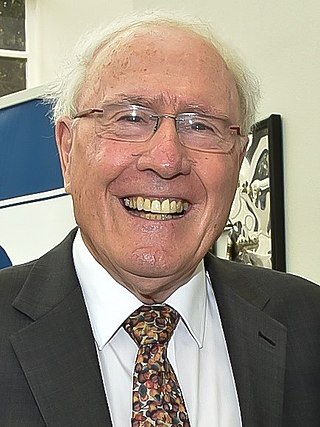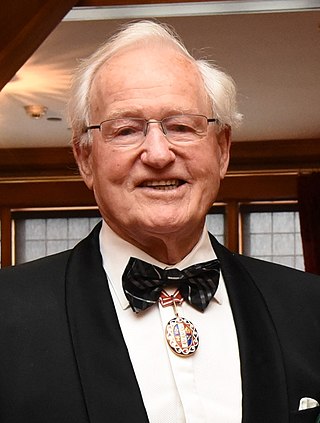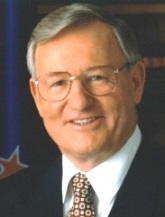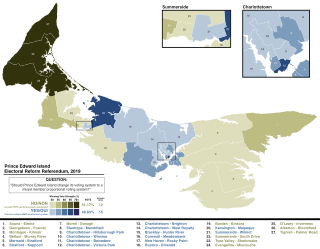Related Research Articles

The politics of New Zealand function within a framework of an independent, unitary, parliamentary democracy. The system of government is based on the Westminster system, and the legal system is modelled on the common law of England. New Zealand is a constitutional monarchy in which King Charles III is the sovereign and head of state, while his prime minister serves as the head of government.
Mixed-member proportional representation is a mixed electoral system which combines local majoritarian elections with a compensatory tier of party list votes, which are used to allocate additional members in a way that aims to produce proportional representation overall. In most MMP systems, voters get two votes: one to decide the representative for their single-seat constituency, and one for a political party. Some countries use single vote variants of MMP, although this article focuses primarily on dual vote versions of MMP.

The New Zealand Parliament is the unicameral legislature of New Zealand, consisting of the Sovereign (King-in-Parliament) and the New Zealand House of Representatives. The King is usually represented by his governor-general. Before 1951, there was an upper chamber, the New Zealand Legislative Council. The New Zealand Parliament was established in 1854 and is one of the oldest continuously functioning legislatures in the world. It has met in Wellington, the capital of New Zealand, since 1865.

Electoral reform in New Zealand has been a political issue in the past as major changes have been made to both parliamentary and local government electoral systems.

Sir Geoffrey Winston Russell Palmer is a New Zealand lawyer, legal academic, and former politician, who was a member of Parliament from 1979 to 1990. He served as the 33rd prime minister of New Zealand for a little over a year, from August 1989 until September 1990, leading the Fourth Labour Government. As minister of justice from 1984 to 1989, Palmer was responsible for considerable reforms of the country's legal and constitutional framework, such as the creation of the Constitution Act 1986, New Zealand Bill of Rights, Imperial Laws Application Act, and the State Sector Act. He served as president of the New Zealand Law Commission, from 2005 to 2010.

James Brendan Bolger is a New Zealand retired politician of the National Party who was the 35th prime minister of New Zealand, serving from 1990 to 1997.

New Zealand is a representative democracy in which members of the unicameral New Zealand Parliament gain their seats through elections. General elections are usually held every three years; they may be held at an earlier date at the discretion of the prime minister, but that usually only happens in the event of a vote of no confidence or other exceptional circumstances. A by-election is held to fill an electorate vacancy arising during a parliamentary term. The most recent general election took place on 14 October 2023.
Parallel voting is a type of mixed electoral system in which representatives are voted into a single chamber using two or more different systems, most often first-past-the-post voting (FPTP) with party-list proportional representation (PR). It is the most common form of mixed member majoritarian representation (MMM), which is why these terms are often used synonymously with each other. In some countries, parallel voting is known as the supplementary member (SM) system, while in academic literature it is sometimes called the superposition method within mixed systems.

Richard William Prebble is a former member of the New Zealand Parliament. Initially a member of the Labour Party, he joined the newly formed ACT New Zealand party under Roger Douglas in 1996, becoming its leader from 1996 to 2004.

The 1996 New Zealand general election was held on 12 October 1996 to determine the composition of the 45th New Zealand Parliament. It was notable for being the first election to be held under the new mixed-member proportional (MMP) electoral system, and produced a parliament considerably more diverse than previous elections. Under the new MMP system, 65 members were elected in single-member districts by first-past-the-post voting, while a further 55 "top-up" members were allocated from closed lists to achieve a proportional distribution based on each party's share of the nationwide party vote.

The 1993 New Zealand general election was held on 6 November 1993 to determine the composition of the 44th New Zealand Parliament. Voters elected 99 members to the House of Representatives, up from 97 members at the 1990 election. The election was held concurrently with an electoral reform referendum to replace the first-past-the-post system, with all members elected from single-member electorates, with mixed-member proportional representation. It saw the governing National Party, led by Jim Bolger, win a second term in office, despite a major swing away from National in both seats and votes, and the carrying of the referendum by 53.9% to 46.1%.

The Royal Commission on the Electoral System was formed in New Zealand in 1985 and reported in 1986. The decision to form the Royal Commission was taken by the Fourth Labour government, after the Labour Party had received more votes, yet it won fewer seats than the National Party in both the 1978 and 1981 elections. It was also a reaction to the power displayed by Prime Minister Robert Muldoon, whose action of illegally abolishing the Superannuation scheme in 1975 without any repercussions highlighted the need to distribute power in a more democratic way. The Royal Commission's report Towards a Better Democracy was instrumental in effecting New Zealand to change its electoral system from first-past-the-post to mixed member proportional.

The New Zealand electoral system has been mixed-member proportional (MMP) since the 1996 election. MMP was introduced following a referendum in 1993. It replaced the first-past-the-post (FPP) system New Zealand had previously used for most of its history. Under MMP, New Zealanders have two secret ballot votes to elect members of Parliament (MPs). The first vote is for a candidate from an electorate, a geographic electoral district. The second is the party vote for the political party the voter wants to form the government.
The Fourth National Government of New Zealand was the government of New Zealand from 2 November 1990 to 27 November 1999. Following electoral reforms in the 1996 election, Jim Bolger formed a coalition with New Zealand First. Following Bolger's resignation, the government was led by Jenny Shipley, the country's first female prime minister, for the final two years.

Voting in New Zealand was introduced after colonisation by British settlers. The first New Zealand Constitution Act was passed in 1852, and the first parliamentary elections were held the following year.
The 2011 New Zealand voting system referendum was a referendum on whether to keep the existing mixed member proportional (MMP) voting system, or to change to another voting system, for electing Members of Parliament to New Zealand's House of Representatives. It was held on 26 November 2011 in conjunction with the 2011 general election.

The 1999 New Zealand MP reduction referendum was held during the 1999 general election on 27 November 1999. The Referendum considered two questions, in which one brought upon the question on whether New Zealand Parliament should be restructured - reducing the number of MPs from 120 to 99 members in the House of Representatives.

A referendum on electoral reform was held on April 23, 2019, in the Canadian province of Prince Edward Island – simultaneously with the 2019 provincial election – to determine if the province should adopt a mixed-member proportional representation voting system (MMP). A narrow majority voted to keep the existing first-past-the-post system. However, the referendum was not binding, as neither the yes or no side received majority support in 60% or more of the province's 27 electoral districts.
Mixed member majoritarian representation (MMM) is type of a mixed electoral system combining majoritarian and proportional methods, where the disproportional results of the majoritarian side of the system prevail over the proportional component. Mixed member majoritarian systems are therefore also as a type of semi-proportional representation, and are usually contrasted with mixed-member proportional representation (MMP) which aims to provide proportional representation via additional compensation ("top-up") seats.
References
- 1 2 3 4 Rod Donald (23 August 2003). "Proportional Representation in NZ - how the people let themselves in - Part I". Green Party of New Zealand. Archived from the original on 16 April 2009.
- ↑ "Campaign for MMP". Archived from the original on 25 May 2015. Retrieved 14 May 2010.
- ↑ "Key Dates in Electoral Reform". Electoral Commission. Archived from the original on 13 October 2008.
- 1 2 3 4 Keith Jackson. New Zealand Adopts Proportional Representation.
- ↑ Brian Easton (1996). "Elitism and the election". The Listener . Retrieved 19 February 2009.
- ↑ "MMP More Popular Post Election" (PDF). Research NZ. 5 December 2008. Archived from the original (PDF) on 13 May 2010. Retrieved 4 March 2009.
- ↑ "Diane Yates - Valedictory statement". TheyWorkForYou. 19 March 2008. Archived from the original on 30 June 2008. Retrieved 19 February 2009.
- ↑ "New Zealand Executive - Ministers: Deborah Morris". 1999. Retrieved 19 February 2009.
- ↑ "STV in New Zealand". Mahurangi Magazine. January 2003. Retrieved 4 March 2009.
- ↑ "STV - One system for Wellington". Scoop.co.nz. 4 September 2008. Retrieved 4 March 2009.